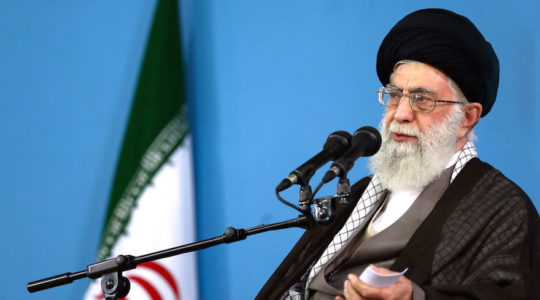
The members of the Ioannina Jewish community, foreign diplomats and local dignitaries take part in a memorial service inside Ioannina’s Kahal Kadosh Yashan synagogue to mark 70 years since the Nazi deportations. (Gavin Rabinowitz)
IOANNINA, Greece (JTA) — When the Jews of Ioannina gathered in their whitewashed-stone synagogue over the weekend, it was to commemorate 70 years since the Nazis destroyed their community.
But the March 30 gathering also served to highlight a source of present-day sadness: the withering of the unique 2,300 year-old Romaniote Jewish tradition.
Ioannina, a postcard-pretty town in northwestern Greece with a medieval fortress perched by a bright blue lake and surrounded by snow-capped mountains, once was the center of Romaniote Jewish life. Today, however, the community in Ioannina numbers fewer than 50 members, most of them elderly. The last time the community celebrated a bar mitzvah was in 2000.
The community’s leaders fear for its future.
“It is very difficult,” said Moses Elisaf, the community’s president. “We try to do our best to keep the traditions, but the numbers are very hard.”
“I don’t like to think about the future. It is very hard to be optimistic,” he said, standing on the peaceful lakefront Mavili Square, where the Nazis loaded the town’s Jews onto trucks to be shipped to Auschwitz.
The Romaniote Jews, neither Ashkenazi nor Sephardic, emerged from the first Jewish communities of Europe. Records indicate the first Jewish presence in Greece dating back to 300 BCE. A ruined second-century BCE synagogue on the Aegean island of Delos is believed to be the oldest discovered in the Diaspora.
These Jews became known as the Romaniotes, speaking their own language, Yevanic, or Judeo-Greek, a version of Greek infused with Hebrew and written with the Hebrew script.

Auschwitz survivor Zanet Nahmia-Sevi (center) lights a candle in memory of the residents of Ioannina who were killed in the Holocaust. (Gavin Rabinowitz)
Romaniote synagogues had a unique layout. They had their own religious traditions and prayer book, the Mahzor Romania. Much of the worship was in Yevanic, and the tunes, including for reading the Torah, were heavily influenced by Byzantine music.
“The Romaniote tradition is hugely important. It is a pre-Diasporic tradition based on the Talmud Yerushalmi,” said Zanet Battinou, the director of the Jewish Museum of Greece and herself a Romaniote who grew up in Ioannina.
But it is a community and a tradition that has long been in decline.
Following the expulsion of the Jews of Spain in 1492, many Sephardic Jews found refuge in the Ottoman Empire that then ruled Greece. Soon, major Sephardic communities sprang up, most notably in Thessaloniki, known as the Jerusalem of the Balkans.
The preexisting Romaniote communities often were absorbed into the larger, wealthier Sephardic Ladino-speaking ones that eventually became largely synonymous with Greek Jewry.
“People don’t know about the Romaniote ancient Jewish community,” Battinou said. “Thessaloniki was so massive and successful, it overshadowed everything.”
It was only on isolated islands and in the rugged mountains of western Greece that the Romaniotes remained the dominant tradition, and Ioannina was the largest of these communities.
By the start of the 20th century, some 4,000 Romaniote Jews lived in Ioannina. But amid the economic hardship and the turmoil that accompanied the breakup of the Ottoman Empire, many joined their Greek compatriots and emigrated.
Most went to the United States and Palestine, setting up Romaniote synagogues in New York City and Jerusalem. Later, a third was established in Tel Aviv. At the start of World War II, about 2,000 Jews remained in Ioannina.
On March 25, 1944, the German Nazi occupiers rounded up the Jews of Ioannina. As snow fell, they were put into open trucks and taken to a nearby city. From there, a nine-day rail journey took them to Auschwitz.
The names of the town’s 1,832 Jews who were murdered are carved on marble tablets on the walls of the synagogue. Among the dead were more than 500 children under the age of 13.

One of the marble tablets on the walls of the synagogue engraved with the names of the 1,832 Jews of Ioannina who perished in the Holocaust. (Gavin Rabinowitz)
Only 112 Ioannina Jews survived the death camps. Another 69 escaped the roundup, hiding with Christian families or fleeing into the mountains, where some fought with the Greek resistance. When they returned to Ioannina, many found their properties looted and homes occupied.
But it was not just the people who were wiped out. Centuries of tradition disappeared, too.
“Oral tradition is very dependent on the third generation — all the grandfathers and grandmothers disappeared, were murdered, all at once,” Battinou said. Among the few survivors was her grandmother Zanet, after whom she is named.
“The youth who survived only perpetuated what parts they remembered,” she said.
While Ioannina was the largest and the most iconic Romaniote community, several other small communities that identify with the Romaniote tradition continue to exist in places like Chalkida and Volos. But today, most of the remaining Romaniote Jews, like their Sephardic compatriots, live in Athens, Greece’s largest Jewish community. Athens has one Romaniote synagogue, built in 1906, but it is used only on the High Holidays.
Meanwhile, the Romaniote Jews who moved to the United States and Israel have intermingled with the larger Jewish communities.

Youth from Ioannina’s Greek community, in traditional dress, hold candles to be lit in memory of the more than 500 children who were deported to Auschwitz. (Gavin Rabinowitz)
Several Israeli Romaniotes attended the anniversary commemorations, drawn by family ties.
Yosef Baruch came with his brother and his uncle at the behest of his 90-year-old grandmother who survived the Nazis and moved to Israel after the war. Baruch says he has never prayed at the Romaniote synagogue in Jerusalem.
“It’s a tradition that was destroyed in the Holocaust,” he said.
None of the American Romaniotes attended the memorial ceremony.
In Greece, with the Jewish community so devastated after the war, there was no place for separate communities. Most religious services are now held according to Sephardic rites.
Today, only Cantor Haim Ischakis, who led the memorial prayer service, knows how to chant the Torah in the Romaniote tradition — something he learned from his father, also a cantor, who survived the camps.
“I am the only one left,” Ischakis said. He is teaching his two sons, but if they don’t take up his profession, the only examples left will be recordings on YouTube.
In fact, the Internet is emerging as the most likely tool for preserving Romaniote tradition. And the impetus for this online push has come from an unlikely source.
The Canadian ambassador to Greece, Robert Peck, who was instrumental in helping organize the commemorations, with Canada heading the International Holocaust Remembrance Alliance, noted the lack of available information about the Jews of Ioannina.
At his behest, the New Media Lab at Vancouver’s Simon Fraser University designed a website detailing Ioannina’s Jewish history, and a soon-to-be-launched app will let people explore Jewish sites in the town and listen to survivor testimonies.
“I came to Ioannina and visited the synagogue, and I felt it was very important to carry beyond the borders of Greece what Ioannina represents, the legacy of the Jewish community here,” Peck said.
Still, the Romaniote Jews hope that through their efforts and dedication, something of their legacy, their community, will survive in the real world.
“It is very precious to me, and I try to pass it on to my children and hope they appreciate that from their mothers’ side, they inherit such a unique tradition,” Battinou said. “It is still alive, it is not extinct, yet.”
JTA has documented Jewish history in real-time for over a century. Keep our journalism strong by joining us in supporting independent, award-winning reporting.





